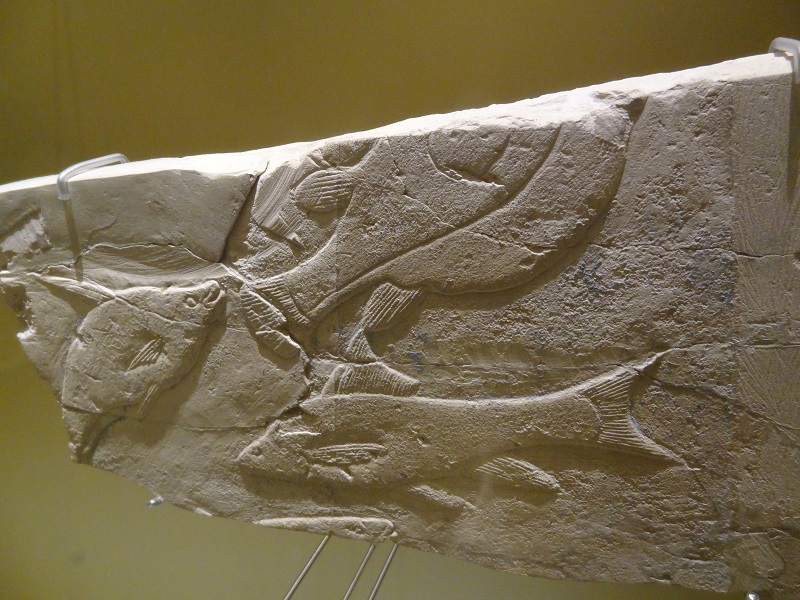I recently visited the Royal Ontario Museum at Toronto, a monumental museum about zoology, paleontology, history, archeology and ethnology. Among the many wonderful objects in the exhibition about ancient Egypt, one artifact caught my eye in particular. It was a very large fishing hook with a massive leader of thick wire elements – all made of bronze.

Here is another photo which shows the hook with some large bronze knifes and baskets to give you a better idea about its size. It was about the size of a hook for big-game-fishing in the sea, or for the largest freshwater fishes like big sturgeons or giant catfish. I have to admit I have a penchant for old and exotic fishing gear, and this one is really one of the coolest ones I have ever seen. From a technical aspect I really admire the work of the ancient smith who made it, the well thought-out construction which helped to avoid a twisting of the line which made it also possible to connect the comparably thin hook with a very strong line. The twisted eyes of the hook and the chain elements provided a maximum of durability. The shape of the hook is not just an U like the much simpler hook on the left, but is highly similar to modern hooks. The diameter in the middle of the curvature is especially thick and slightly flattened to withstand heavy loading. Whoever forged this some thousand years ago – he knew exactly what it needs to catch a monster fish.

Today we find nearly identical constructions for shark hooks in which a massive swivel protects the line when the shark is spinning, and a short chain against the sharp shark teeth. Here is an example from the Deutsches Jagd-und Fischerei-Museum (Museum für hunting and fishing) at Munich, from a temporary special exhibition about sharks:

You can see an even more similar example of a historical shark hook which includes also a chain here.
The African continent is particularly poor in big freshwater fish, and only few species grow to sizes bigger than a meter. There is however one big exception, a fish which reaches enormous dimensions, the nile perch Lates niloticus. This behemoth can exceed lengths of 1,8 m and weights well over 100 kg, making it one of the heaviest freshwater fishes of the world. As usual there are a lot of anecdotes and hardly confirmable dates about much bigger specimens, what makes it quite hard to give more precise sizes and weights.

Even before this species was introduced to many bodies of water in which it was originally not native (with desastrous effects, like in Lake Victoria) it had a very large range, which included the nile in North Africa. The ancient Egyptians were well familiar with this fish, and there are even cases known of mummified nile perches, like this specimen in the Egyptian Museum at Cairo. Fish was caught with nets, harpoons and also hook and line (which included simple rods but also handlines), and it was an important source of protein. Most of those fish were however comparably small, species like cyprinids, tilapias or smaller and medium sized catfishes. Catching the really big nile perches was probably not that easy as it required special gear. The fabrication of this hook was probably already a lot of work and bronze was still very valuable even at small amounts at that time.

Bones of large nile perches were also found among other animal relics at archeological sites, sometimes in form of waste, sometimes as burial objects. Some of them include relics of really huge specimens, like several nile perches from the necropolis of Elephantine which were about 1,8 m in life. One particular specimen was even about 1,9 m. There were also a lot of nile perch bones found at the temple of Satis, which included several very large specimens, including one of about 1,9 m. It´s noteworthy that this is still not bigger than the largest modern day nile perches from the big lakes in their more southern range. Today such huge specimens are no more found at Egypt anymore, but it seems that they were considerably more common in the past, and the ancient fisherman obviously managed to catch them.

As nile perches usually prefer comparably deep water, they were likely rarely caught with harpoons, and it seems likely that they were also no common targets for neting, at least not the big ones. So angling with hook and line in big game style was likely the most efficient way to target particularly big specimens, which had also surely a considerable worth. The ancient Egyptians called the nile perch „the fighter“, what also possibly indicates its behavior when it was caught with hook and line. Those fishermen had nothing even remotely comparably to the modern fibreglas rods and reels, but just handlines to catch those enormous fish which could weigh considerably more than an average human.
If you want to learn more about fishes and fishing in ancient Egyptian art and culture, take a look at those links: 1, 2, 3.
Sources:
BOESSNECK, J. und von den DRIESCH, A. (1982): Studien an subfossilen Tierknochen aus Ägypten. – Münchener Ägyptol. Studien, 40:58, München-Berlin.
